Abstract
The dominant cecal bacteria in the high-arctic Svalbard reindeer were characterized, their population densities were estimated, and cecal pH was determined in summer, when food quality and availability is good, and in winter, when it is very poor. In summer the total culturable viable bacterial population was (8.9 +/- 5.3) X 10(8) cells ml-1, whereas in winter it was (1.5 +/- 0.7) X 10(8) cells ml-1, representing a decrease to 17% of the summer population density. Of the dominant species of cultured bacteria, Butyrivibrio fibrisolvens represented 23% in summer and 18% in winter. Streptococcus bovis represented 17% in summer and 5% in winter. Bacteroides ruminicola represented 10% in summer and 26% in winter. In summer and winter, respectively, the proportion of the viable population showing the following activities was as follows: fiber digestion, 36 and 48%; cellulolysis, 10 and 6%; xylanolysis, 33 and 48%; and starch utilization, 77 and 71%. The most abundant cellulolytic species in summer was Butyrivibrio fibrisolvens, representing 62% of the total cellulolytic population, and in winter it was Ruminococcus albus, representing 80% of the total cellulolytic population. The most abundant xylanolytic species in summer was Butyrivibrio fibrisolvens, and in winter it was Bacteroides ruminicola, representing 59 and 54% of the xylanolytic isolates in summer and winter, respectively. The cecal bacterial of the Svalbard reindeer have the ability to digest starch and the major structural carbohydrates of the diet that are not digested in the rumen. The cecum in these animals has the potential to contribute very substantially to the digestion of the available plant material in both summer and winter.
Full text
PDF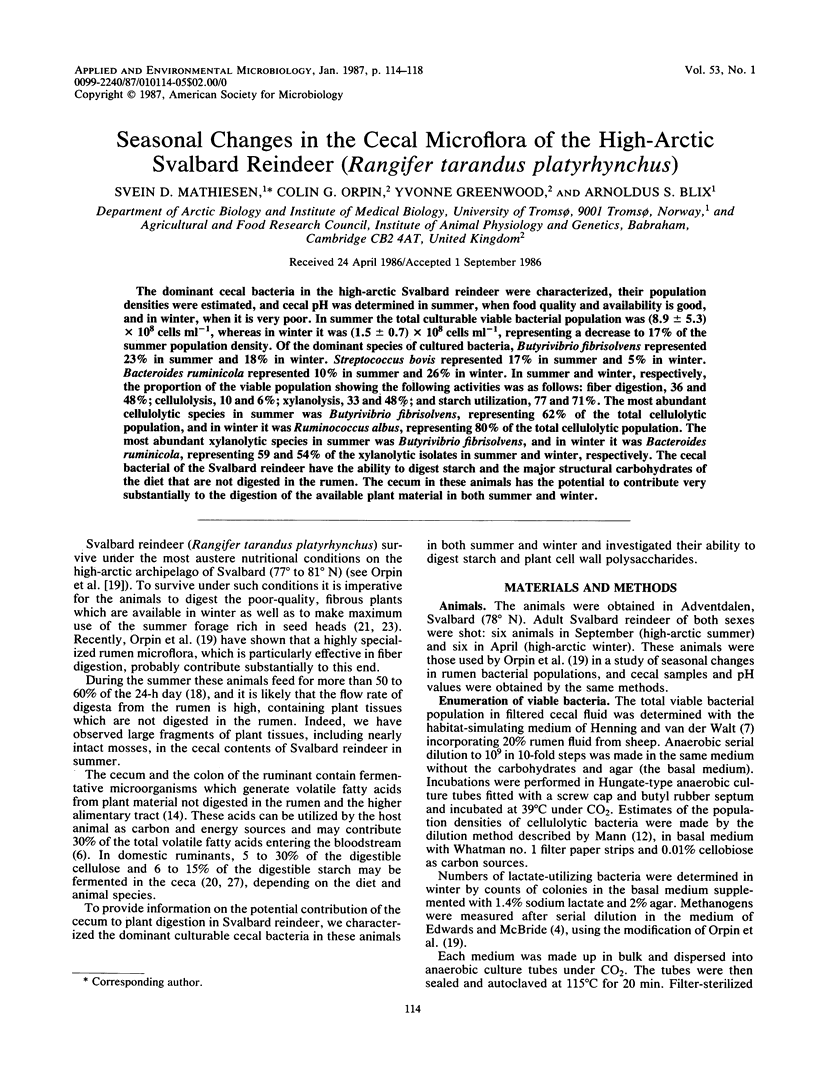
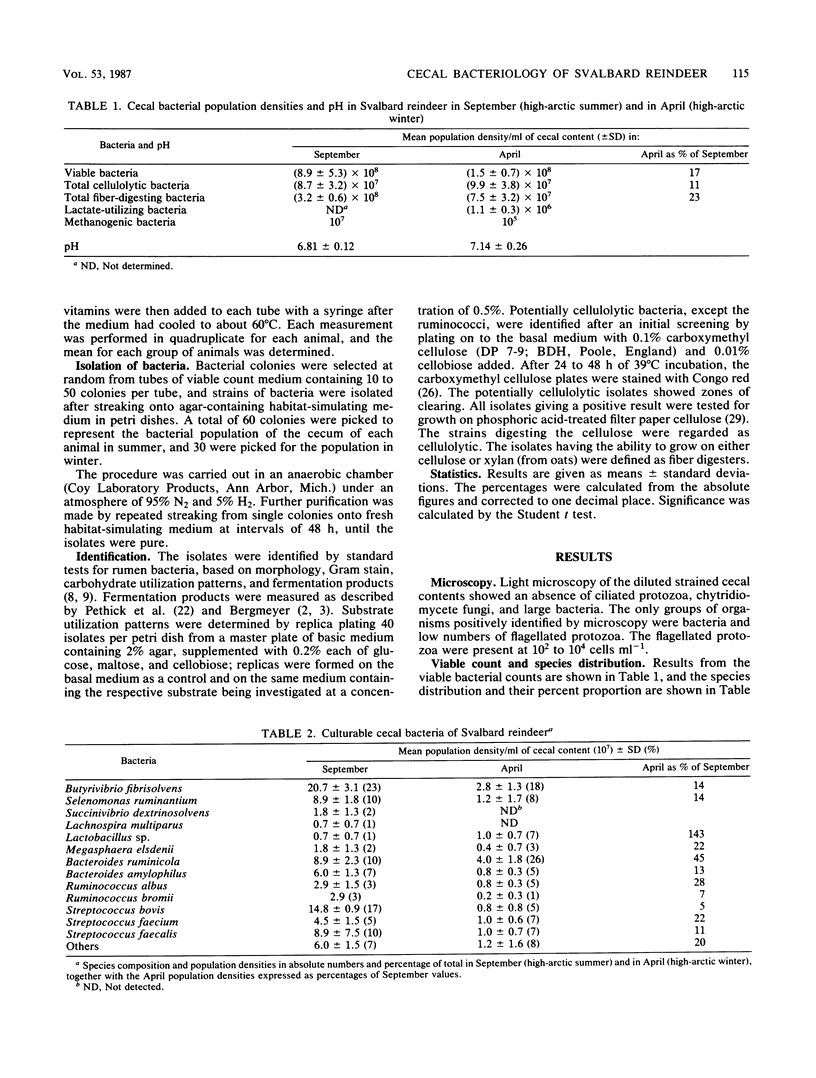
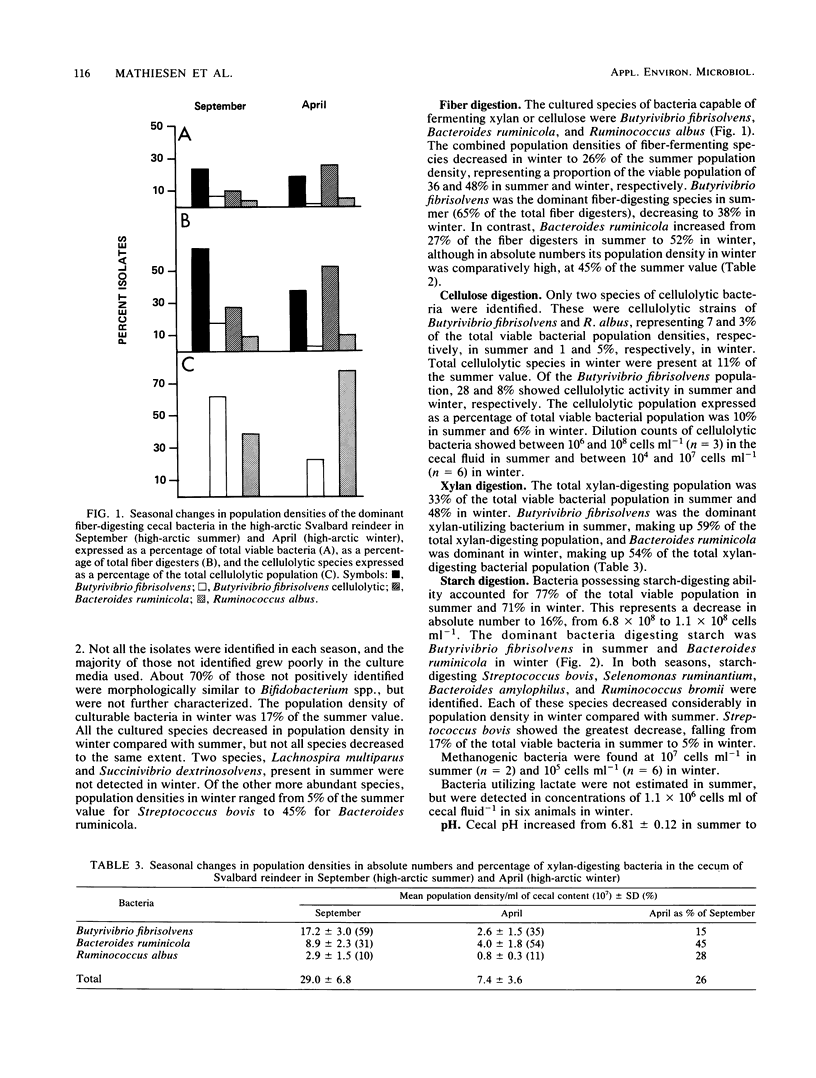
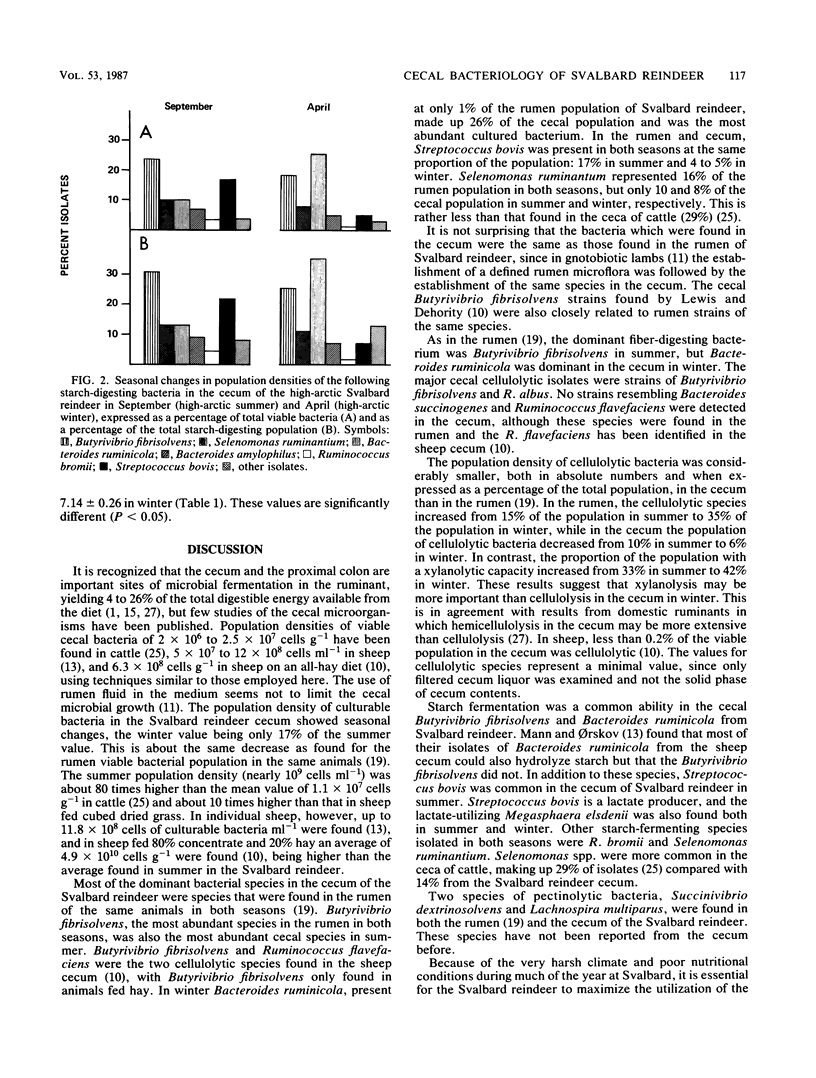
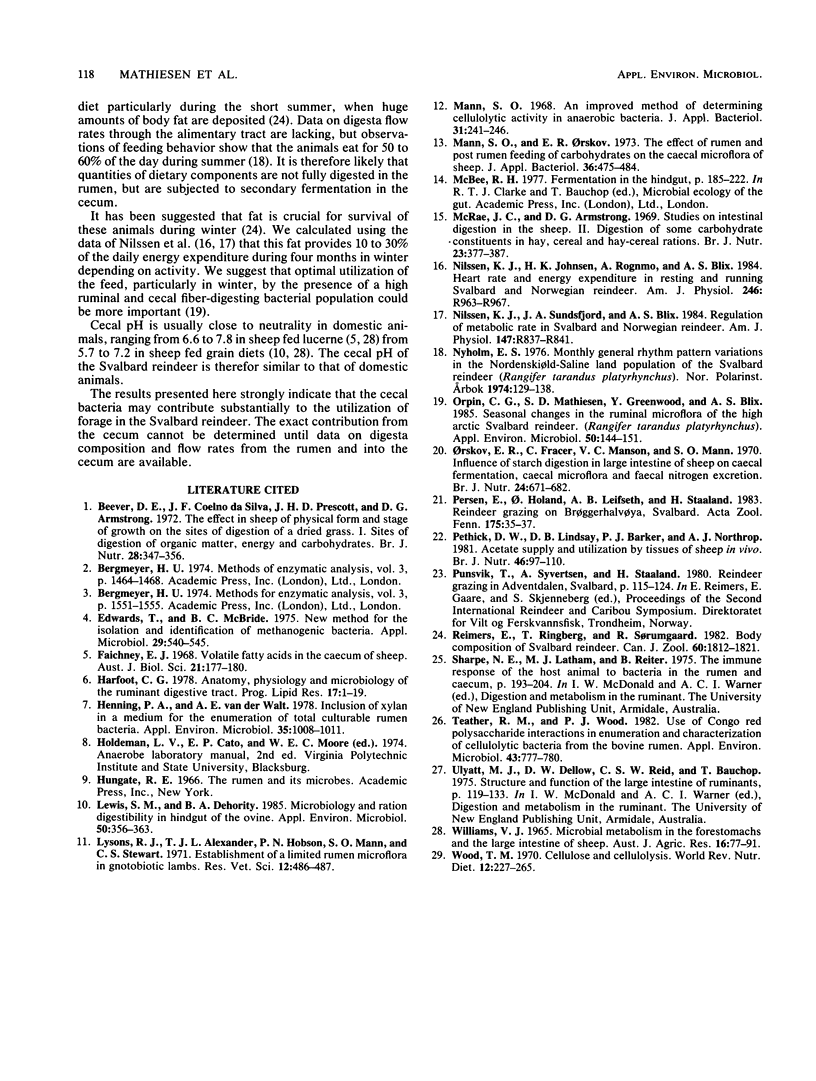
Selected References
These references are in PubMed. This may not be the complete list of references from this article.
- Beever D. E., Coelho da Silva J. F., Prescott J. H., Armstrong D. G. The effect in sheep of physical form and stage of growth on the sites of digestion of a dried grass. 1. Sites of digestion of organic matter, energy and carbohydrate. Br J Nutr. 1972 Nov;28(3):347–371. doi: 10.1079/bjn19720044. [DOI] [PubMed] [Google Scholar]
- Edwards T., McBride B. C. New method for the isolation and identification of methanogenic bacteria. Appl Microbiol. 1975 Apr;29(4):540–545. doi: 10.1128/am.29.4.540-545.1975. [DOI] [PMC free article] [PubMed] [Google Scholar]
- Faichney G. J. Volatile fatty acids in the caecum of the sheep. Aust J Biol Sci. 1968 Feb;21(1):177–180. [PubMed] [Google Scholar]
- Harfoot C. G. Anatomy, physiology and microbiology of the ruminant digestive tract. Prog Lipid Res. 1978;17(1):1–19. doi: 10.1016/0079-6832(78)90003-4. [DOI] [PubMed] [Google Scholar]
- Henning P. A., van der Walt A. E. Inclusion of xylan in a medium for the enumeration of total culturable rumen bacteria. Appl Environ Microbiol. 1978 Jun;35(6):1008–1011. doi: 10.1128/aem.35.6.1008-1011.1978. [DOI] [PMC free article] [PubMed] [Google Scholar]
- Lewis S. M., Dehority B. A. Microbiology and ration digestibility in the hindgut of the ovine. Appl Environ Microbiol. 1985 Aug;50(2):356–363. doi: 10.1128/aem.50.2.356-363.1985. [DOI] [PMC free article] [PubMed] [Google Scholar]
- Lysons R. J., Alexander T. J., Hobson P. N., Mann S. O., Stewart C. S. Establishment of a limited rumen microflora in gnotobiotic lambs. Res Vet Sci. 1971 Sep;12(5):486–487. [PubMed] [Google Scholar]
- Macrae J. C., Armstrong D. G. Studies on intestinal digestion in the sheep. 2. Digestion of some carbohydrate constituents in hay, cereal and hay-cereal rations. Br J Nutr. 1969 Jun;23(2):377–387. doi: 10.1079/bjn19690044. [DOI] [PubMed] [Google Scholar]
- Mann S. O. An improved method for determining celluloytic activity in anerobic bacteria. J Appl Bacteriol. 1968 Jun;31(2):241–244. doi: 10.1111/j.1365-2672.1968.tb00363.x. [DOI] [PubMed] [Google Scholar]
- Mann S. O., Orskov E. R. The effect of rumen and post-rumen feeding of carbohydrates on the caecal microflora of sheep. J Appl Bacteriol. 1973 Sep;36(3):475–484. doi: 10.1111/j.1365-2672.1973.tb04130.x. [DOI] [PubMed] [Google Scholar]
- Nilssen K. J., Johnsen H. K., Rognmo A., Blix A. S. Heart rate and energy expenditure in resting and running Svalbard and Norwegian reindeer. Am J Physiol. 1984 Jun;246(6 Pt 2):R963–R967. doi: 10.1152/ajpregu.1984.246.6.R963. [DOI] [PubMed] [Google Scholar]
- Nilssen K. J., Sundsfjord J. A., Blix A. S. Regulation of metabolic rate in Svalbard and Norwegian reindeer. Am J Physiol. 1984 Nov;247(5 Pt 2):R837–R841. doi: 10.1152/ajpregu.1984.247.5.R837. [DOI] [PubMed] [Google Scholar]
- Orpin C. G., Mathiesen S. D., Greenwood Y., Blix A. S. Seasonal changes in the ruminal microflora of the high-arctic Svalbard reindeer (Rangifer tarandus platyrhynchus). Appl Environ Microbiol. 1985 Jul;50(1):144–151. doi: 10.1128/aem.50.1.144-151.1985. [DOI] [PMC free article] [PubMed] [Google Scholar]
- Orskov E. R., Fraser C., Mason V. C., Mann S. O. Influence of starch digestion in the large intestine of sheep on caecal fermentation, caecal microflora and faecal nitrogen excretion. Br J Nutr. 1970 Sep;24(3):671–682. doi: 10.1079/bjn19700068. [DOI] [PubMed] [Google Scholar]
- Pethick D. W., Lindsay D. B., Barker P. J., Northrop A. J. Acetate supply and utilization by the tissues of sheep in vivo. Br J Nutr. 1981 Jul;46(1):97–110. doi: 10.1079/bjn19810013. [DOI] [PubMed] [Google Scholar]
- Teather R. M., Wood P. J. Use of Congo red-polysaccharide interactions in enumeration and characterization of cellulolytic bacteria from the bovine rumen. Appl Environ Microbiol. 1982 Apr;43(4):777–780. doi: 10.1128/aem.43.4.777-780.1982. [DOI] [PMC free article] [PubMed] [Google Scholar]
- Wood T. M. Cellulose and cellulolysis. World Rev Nutr Diet. 1970;12:227–265. doi: 10.1159/000387589. [DOI] [PubMed] [Google Scholar]


